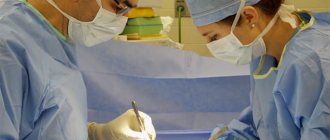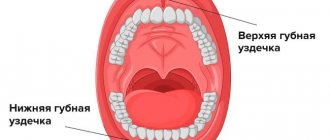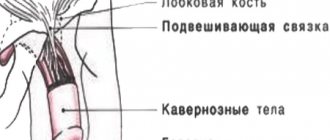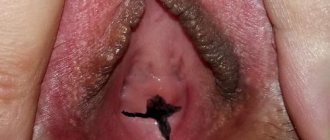Partial circumcision of the foreskin - what is it?
Partial circumcision, more accurately called “incomplete circumcision,” is a surgical procedure in which only part of the foreskin (prepuce) of the penis is removed, leaving the head of the penis partially covered.
If complete circumcision is performed primarily in accordance with the cultural and religious traditions of a man and is much less often performed for medical reasons, then incomplete circumcision is a purely medical procedure, that is, not in any way related to culture or religion.
History of circumcision
The first information about circumcision appears among the ancient peoples of Phoenicia and Babylon; similar practices are found among indigenous Australians and many tribes in Africa. The Egyptians, the first adherents of Christianity, practiced circumcision. Circumcision has become firmly established among the Jewish people.
Removal of the foreskin was associated with the boy's growing up, but among most peoples the procedure was of a religious nature. [12]
Currently, many peoples have preserved ritual and religious circumcision, which is performed by special people or they are present during the procedure performed by a surgeon. Research shows that circumcision is useful for the prevention of many urological diseases in both men and women. But circumcision is not recommended as a routine procedure performed on all newborn boys. [
Indications for incomplete circumcision
The main indication for partial circumcision is phimosis (narrowness of the foreskin, making it difficult to freely expose the head of the penis), while the patient does not want to completely remove the prepuce. In this case, if the phimosis is localized on the upper or middle part of the foreskin, the doctor can excise only that area of the prepuce that directly prevents the free exposure of the head of the penis.
Other indications for incomplete circumcision include:
- hypertrophic (proboscis) phimosis - excessive growth of the foreskin, when exposure of the head of the penis does not occur even with a full erection;
- polyps or condylomas on the foreskin;
- chronic balanoposthitis - inflammation of the inner part of the prepuce;
- trauma - if it is impossible to restore the foreskin.
Contraindications
Circumcision is a minor surgical procedure, but it requires preparation and examination. It allows you to exclude conditions in which surgery or the use of anesthesia is contraindicated.
A child should not be circumcised if he or she has abnormalities in the development of the penis. These include:
- urethral hypospadias is an anomaly in which the opening of the urethra may not be on the head, but under it, on the body, at the base or scrotum;
- epispadias – complete or partial splitting of the urethra. [1]
In this condition, circumcision is technically impossible; the boy requires plastic surgery to restore the urethra. [7]
A relative contraindication to circumcision is inflammatory diseases of the penis. In some cases, circumcision is the only way to relieve the condition. In case of pathologies of blood bleeding, the operation is performed with caution. For the same reason, it is not recommended to circumcise newborns up to 8 days old; physiological deficiency of vitamin K and insufficiency of the coagulation system affect it. [1]
If a patient must take anticoagulants or antiplatelet drugs but needs to be circumcised, they should stop using the medications 2-3 days before surgery and resume treatment after surgery. [8]
Separate contraindications to surgery are somatic diseases, in which anesthesia is contraindicated, and allergies to anesthetic agents. Such conditions include severe diseases of the cardiovascular and respiratory systems, uncompensated diabetes mellitus, any decompensated disease of internal organs, and a febrile state.
Types of partial circumcision
Based on the nature of the procedure, the incomplete circumcision procedure can be divided into two types:
- High cut.
A small part of the foreskin is removed, as a result of which the head of the penis is exposed to a maximum of the middle.
- Low cut.
The foreskin is removed along the coronal groove of the penis.
The issue of preserving or removing the frenulum during partial circumcision is decided individually based on the reasons for which the operation is performed.
Preparation for circumcision
Circumcision is carried out as planned. Therefore, after visiting a urologist, the patient must undergo an examination. Referrals are provided for the following tests:
- clinical blood test;
- general urine analysis;
- coagulogram;
- biochemical blood test, including glucose;
- ECG;
- analysis for HIV, syphilis, hepatitis;
- smear for gonorrhea.
For chronic diseases, additional examination may be prescribed to clarify the patient’s condition and ability to undergo anesthesia and surgery. [8]
How is incomplete circumcision performed?
Partial circumcision is performed under local or general anesthesia using a surgical scalpel or laser. The operation itself is performed as follows:
- The foreskin is fixed and stretched. Sometimes, for the convenience of the surgeon, the penis is placed in a state of artificial erection.
- The prepuce is excised in a circle to the required extent.
- Sutures made of self-absorbing materials are placed at the incision site, and an antiseptic bandage is placed over the sutures.
In general, the incomplete circumcision operation lasts no longer than half an hour. Complete hospitalization after partial circumcision is not required; after 2-4 hours the patient can freely leave the medical facility.
Features of rehabilitation after partial circumcision
Complete healing of the circumcised foreskin occurs within 1-4 weeks, depending on the general physical condition of the patient and the method of surgery. During this period, the patient is prohibited from:
- have sexual intercourse or masturbate;
- engage in active sports;
- visit the pool, bathhouse or sauna.
To relieve postoperative pain, patients are prescribed a general pain reliever - analgin, ketanov, etc. Dressings and scar care are performed using those antiseptic and/or antibacterial agents prescribed by the attending physician. It is also recommended to gently wash the penis with warm water after each urination.
Possible complications
Complications that may occur after circumcision of the foreskin include:
- Bleeding. During the first 2-3 days, slight bleeding is normal. To stop the bleeding, you need to apply pressure to the bleeding area with a sterile cloth or bandage for 5-10 minutes.
- Suppuration. Occurs when the postoperative scar is not properly cared for and requires the intervention of a urological surgeon.
- Swelling. Can last up to 2-3 weeks. An alarming sign is increased swelling with the addition of severe pain.
- Peeling of the head of the penis. A variation of the normal reaction of the scalp to the removal of protection in the form of the prepuce. The crusts that appear during the peeling process can be soaked with chlorhexidine.
- Lumps under the foreskin. Usually we are talking about thrombosed vessels, which spontaneously resolve within a month.
- Difficulty urinating. Often caused by a psychological fear of urinating immediately after surgery, which disappears within 1-2 days, but in the presence of pain it can be a sign of an inflammatory process.
If the listed complications do not disappear over the specified period of time, the patient should see his doctor.
How is the operation performed?
If you want to understand what male circumcision looks like, then it is worth knowing that the principle of circumcision is to circumcise the foreskin in a circle using a sharp surgical knife - a scalpel. It is noteworthy that the procedure, which is performed by Jews and Muslims, is often performed without anesthesia (anesthesia is simply prohibited). Therefore, the boy may be in quite a lot of pain. In addition, stitches are also not required.
To know why infant boys are circumcised, for example, Jews believe that on the eighth day a child is considered to have survived one Saturday (Shabbat), and therefore to have completed half the sacred journey. The second half of sanctification is circumcision.
In a clinical setting, circumcision is performed under local anesthesia. To do this, the penis is initially tightened at the base and then an anesthetic injection is given into it. After just 2-3 minutes, the sensitivity of the penis is completely neutralized.
During the operation, the surgeon retracts the foreskin and secures it with special clamps. After this, the doctor makes a skin incision along the body of the penis and removes its excess. Stitches are placed on the incision, which are removed after 10-14 days. The operation itself lasts no more than 20-25 minutes.
Circumcision methods
If the reader wants to understand what circumcision looks like (how the procedure is carried out) in more detail, then in this case it is worth considering that there are various methods for removing the foreskin. In particular, both old and new methods are used. The old ones include:
Appointment with a urologist: preparation for examination, diagnosis and treatment measures
- Removing the foreskin using clamps. The oldest and most proven method over the years. When performing such manipulation, clamps remain on the patient’s penis for up to 5-7 days, thanks to which the skin heals completely. This method does not require special devices and tools. With such an operation, the doctor can cope even without the help of an assistant. Such circumcision can be carried out even in the most modest municipal clinic. However, the main disadvantage of the method is the remaining skin of approximately 0.5-1 cm around the head of the penis.
- Circulation cut method. Here, excess skin is removed using a circular cut. In order to perform an operation, the surgeon needs an assistant. The circular cutting method is especially relevant if a man has clearly visible large veins on his penis.
- Dorsal cutting method. It is especially often used in relation to patients with phimosis. Thanks to this method, the risk of curvature (asymmetry) of the penis after surgery is reduced to zero. The scar is formed extremely smooth and neat.
New techniques for performing circumcision include laser circumcision. Here the skin of the penis is treated with a laser. It is noteworthy that the procedure can be performed on both adult men and infants and boys of any age. With all the benefits of laser circumcision before and after, men develop a persistent optimistic mood. This is due to the following advantages of laser removal of the foreskin:
- Complete bloodlessness of the operation. This is achieved thanks to a laser, which immediately seals the blood vessels when cutting off tissue.
- Painless operation. When using a laser, even the simplest anesthesia can be applied. And the pain after circumcision is less intense than after standard surgery.
- No swelling of the penis after surgery.
- Parallel disinfection of the wound surface during surgery. The laser is also an antiseptic.
- The recovery period is 5-7 days, since healing occurs faster.
The new method of removing the foreskin is carried out for any medical indication.
Basic questions about partial circumcision
1. Will penis size change after circumcision?
No, the size of the penis will not change in any way, although visually, due to the absence of the foreskin, the penis may be subjectively perceived by a man (or his sexual partner) as having increased or decreased.
2. Does your sex life suffer after partial circumcision?
In general, no. However, in the first 1-2 months, men do notice a certain discomfort, which is explained by the unfamiliarity of having sex with a partial absence of the prepuce. As you get used to it, your sex life will become completely normal.
3. Is it true that with partial circumcision it takes longer to get used to the friction of the head?
This is quite subjective, but generally speaking, getting used to the friction may actually take a little longer than with complete circumcision. The reason for this is the incomplete opening of the head of the penis, as a result of which only a small part of it is exposed to friction, which slows down the process of addiction.
Main types of circumcision
In modern medicine, there are several basic methods for getting rid of soft tissue from the penis. The method directly determines how the operation itself will be performed and what the penis will look like in the end. The most popular methods:
- Minimal trimming is the removal of a small part of the skin, which allows you to preserve all its functions and slightly reduce its size;
- Excision of the complete part - in this case, a larger part of the soft tissue is removed than in the first operation, the apex is only slightly covered. In this option, laser circumcision is often used;
- Free type removal - the most common type, the erect part of the penis is completely exposed; tight circumcision is the rarest method; the tissue is completely removed. After this procedure, the skin stretches greatly and becomes thinner.
Circumcision (circumcision)
Circumcision is the complete or partial removal of the foreskin on the penis by surgical method. Such operations are quite popular in the modern world, since in addition to medical indications, there are other motivations that push the stronger half of humanity towards circumcision.
Indications for circumcision
There are several indications for circumcision of the foreskin:
- Medical, that is, as a type of treatment or for preventive purposes.
— Religious and national indications. In the modern world, as many centuries ago, the tradition of circumcision among Muslims has been preserved. The Jewish people also go through this procedure, which is the main indicator of belonging to the nation.
— Aesthetic, hygienic, social beliefs.
Circumcision as a treatment method
As mentioned above, circumcision may be a medical condition. First, let's take a closer look at the diseases for which surgical intervention is recommended.
Phimosis
Circumcision is performed for phimosis, i.e. a defect in which it is impossible or difficult to expose the head of the penis in men due to the narrowed foreskin. This problem can occur when the penis is injured and a scar appears, resulting in the formation of cicatricial phimosis. Phimosis can also be congenital, since a man may have a lack of elastic component or insufficiency of connective tissues.
Degrees of phimosis:
- First degree: in a calm state of the penis, the man does not have difficulty opening the head; during an erection, exposure may become difficult or painful.
- Second degree: in a calm state it is difficult to expose the head of the penis, with an erection - opening is impossible, severe pain.
- Third degree: there may be a slight opening of the head or not exposed at all.
— Fourth degree: the head of the penis does not open, urination is difficult.
Paraphimosis
Paraphimosis is the pinching of the head of the penis by the foreskin during sexual intercourse or masturbation. This defect is accompanied by swelling of the head of the penis, severe and sharp pain, and reduction is impossible. In this case, it is impossible to do without qualified medical care. In rare cases, the doctor will reset the head, but in most cases surgery is necessary. The surgical intervention consists of cutting the foreskin along the penis.
Circumcision is also an indication for some other diseases, for example:
— chronic balanoposthitis;
- penile herpes.
Circumcision – prevention of cancer and sexually transmitted infections
If we talk about tumors on the penis, in particular cancer, then this disease is extremely rare in men who have undergone this procedure than in those who have not decided on circumcision. It is not difficult to explain this fact: under the foreskin, a substance accumulates - smegma, which is secreted by the sebaceous glands, and it is this substance that has carcinogenic properties, which can provoke the appearance of cancer cells.
Men with circumcised flesh do not have to worry about cancer. Moreover, they are also not at risk of various infections of the genitourinary system.
As for various viruses, including HIV, men with uncircumcised flesh are at greater risk of becoming infected than those who have undergone this procedure. After all, the foreskin is quite often subject to microtrauma, which allows viruses to enter the body. After the operation, the skin of the glans penis will become rougher, which will be an additional defense for the body against the penetration of viruses.
If we consider circumcision of the foreskin of the glans penis in men from the point of view of hygiene, then this operation is indicated for everyone without exception. After all, urine residues and smegma accumulate under the foreskin, which is an excellent environment for bacteria to live and multiply. And circumcision will very quickly solve this unpleasant problem.
Does circumcision improve the quality of sex?
Many men who have undergone this procedure claim that the quality of sex improves, the duration of sexual intercourse itself increases, the quantity increases, some claim that the strength of sensations increases.
If we talk about premature ejaculation, a rather delicate problem, then circumcision can also eliminate this problem. Unwanted, premature and accelerated ejaculation not only leads to discomfort, but can also ruin your entire sex life. A large number of men encounter this phenomenon, statistics say about 30%. After surgery, the sensitivity of the glans penis decreases (this occurs due to thickening of the skin) and, as a result, the duration of sexual intercourse will increase.
Contraindications to circumcision of the foreskin in men
Of course, as with any operation, this one also has a certain number of contraindications to its implementation. The main ones are: - various anatomical anomalies of the genital organs; — pathologies of penile development; - discharge; - ulcers, wounds on the penis.
Before the operation, each patient must receive a consultation, undergo an examination, take the necessary tests; if additional diagnostics are needed in order to assess whether there are contraindications to surgical intervention, this must also be done. All this can be done in our clinic, from us you can get answers to all your questions, and we will also provide all the necessary information on the operation, and tell you about all the advantages of circumcision.
Modern techniques for performing circumcision surgery
You can undergo circumcision surgery in Moscow in our modern clinic. We perform the operation using two methods: - alternative, which is indicated for young children, as well as for those cases when it is impossible to open the head of the penis; - two-incision technique.
Before the operation, the anesthesiologist, together with the patient, decides on the type of anesthesia. The doctor will answer all your questions, advise on preparation for surgery, and give advice for the postoperative period.
The operation itself does not last long, on average it takes half an hour. Within a few hours after surgery, the patient can go home. The operation is simple, quick, and the postoperative period is short. If the patient follows all the doctor’s recommendations and prescriptions, then within two weeks after surgery he can be sexually active.
The aesthetic side of circumcision surgery
Naturally, along with medical indications, our specialists pay great attention to the aesthetic side. We understand that we are talking not only about the vital male organ, but also about its beauty. Rest assured that our qualified medical staff will perform the operation professionally, and you will be satisfied with the result!










